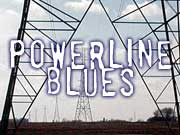Powerline Blues
December 9, 2002
 |
| Farmers protest plans for a transmission line through their farmland. (Photo courtesy of Star Tribune) |
If the project is approved, it will be the biggest one built in Minnesota since a nationwide boom in transmission line construction ended 20 years ago. Some in the industry say now we need to build the next wave of transmission lines. But in Minnesota, many people remember a time when a powerline project went wrong.
In the late 1970s, a mass protest swept through the normally conservative farm country of west central Minnesota. Farmers tried to stop construction of a 400-mile-long transmission line that would cross their land on the way from North Dakota to the Twin Cities. A system, which line opponents said was unfair, turned ordinary people into radicals.
Undated — From the beginning, it didn't seem fair to farmer Virgil Fuchs. The way he saw it, the route for the powerline crossed his land because the big, irrigated farms to the south of him didn't want it. Fuchs believed the big farmers had told the power company that the line couldn't cross their land because it would interfere with their huge irrigation rigs.
Fuchs and his neighbors were mostly smaller farmers. As a result, he felt, they were the ones who got stuck.
 | |||
"We had land to the south of us (that) you could drive for 10 miles and you wouldn't see a farm place, yet they didn't want to have the line," he says.
Fuchs got word that the irrigators had passed a resolution saying the powerline should go where the land was "less productive." In other words, through his neighborhood, not theirs.
Angry and insulted, he got a map of the powerline's route and drove to every farm it would cross, spreading the news.
"And for them to describe it as less productive farmland upset everybody that I showed it to. I got the resolution somehow that was passed, and showed it to these other people, and you don't have to be a rocket scientist to see somebody is trying to pull something over on you," Fuchs says.
Right on his heels, Fuchs remembers, came the power company, asking farmers to sign easements. "I was probably ahead of them by about two or three days. The utility company didn't get one easement. From western Stearns County to Paynesville, they didn't gain one extra easement after we found out about it."
Just a few miles down the road from Virgil Fuchs, John and Alice Tripp ran a dairy farm. It also stood in the path of the powerline. It upset John Tripp that much of the line would cut diagonally across farmers' land, making it harder to plow, plant, and harvest.
 | |||
"At the time I likened it to, if you were shopping in a grocery store and you went down the aisle, then it was blocked, and you'd have to come back out again, and go down another aisle, and then it would be blocked. I likened it to that a little bit. But I do believe that it's the idea of taking land. It really bothers people. They think that's their land, you know," says John Tripp.
Local townships passed resolutions against the powerline. Some county boards refused to grant permits. So in the spring of 1975, the two utilities proposing the line, United Power Association and Cooperative Power Association, turned to the state of Minnesota. The state would designate the route under the recently passed Minnesota Power Plant Siting Act.
Virgil Fuchs and his wife, Jane, hoped that having the state step in would help them. "We talked to different representatives and senators, and they said, 'OK, now this is going to be great. Now the state is going to have some say,'" Jane Fuchs recalled in an interview with the Minnesota Historical Society. "And routing powerlines in the past, the power company has been able to go wherever they wanted to go, and the state has had no say. Now we're going to have public hearings. The people can come and voice their opinions…and if you have lots of resistance, you won't have the line. That's what they told us."
Jane Fuchs explained it further in a recent interview. "This is what we thought through the whole process. We would discuss our issues, what our concerns were, and they would help us. That's what the government would do for us."
But it didn't work that way. A state agency, then called the Environmental Quality Council, held numerous public hearings, but six months after the utilities went to the EQC, the agency approved the route.
Grant County, which lay in the powerline's path, appealed to a district court, but a judge dismissed the case. And in June 1976, a year after the utilities' request, the state issued a construction permit. Three days later, utility company surveyors arrived at Virgil and Jane Fuchs' farm.
"We had gone to all the hearings and we had been informed that we would get official notice from the government telling us which day they would be out on our farm to start work. And we never received the notice, and one day they were out in the field. So, things happened," says Fuchs.
Virgil Fuchs refuses to discuss what occurred that day, but he was charged with two felony counts.
|
News Headlines
|
Related Subjects
|

